Analysis and Optimization of Jack Automotive Line Balancing Strategy
VerifiedAdded on 2020/03/16
|16
|3781
|468
Report
AI Summary
This report presents a comprehensive analysis of Jack Automotive's line balancing strategy, examining the company's manufacturing processes to identify areas for optimization. The report begins with an introduction to the concept of line balancing, emphasizing its importance in high-volume manufacturing environments like the automotive industry. It then provides a detailed literature review, covering different types of assembly lines and the methodology used in line balancing, including the calculation of takt time and the development of process charts. The study employs a qualitative research approach using secondary data to assess the effectiveness of the company's current line balancing practices. Findings highlight the importance of balance loss, line layout, productivity, ergonomic risks, and assembly complexity. The report concludes with recommendations for future work, particularly focusing on ergonomic risk mitigation and assembly complexity improvements. The goal is to enhance the efficiency of the assembly line and to meet customer demands effectively by reducing cycle time and optimizing workstation utilization. The report also provides insights into the company's productivity, balance loss, and layout, offering strategies to reduce costs and improve overall manufacturing performance.
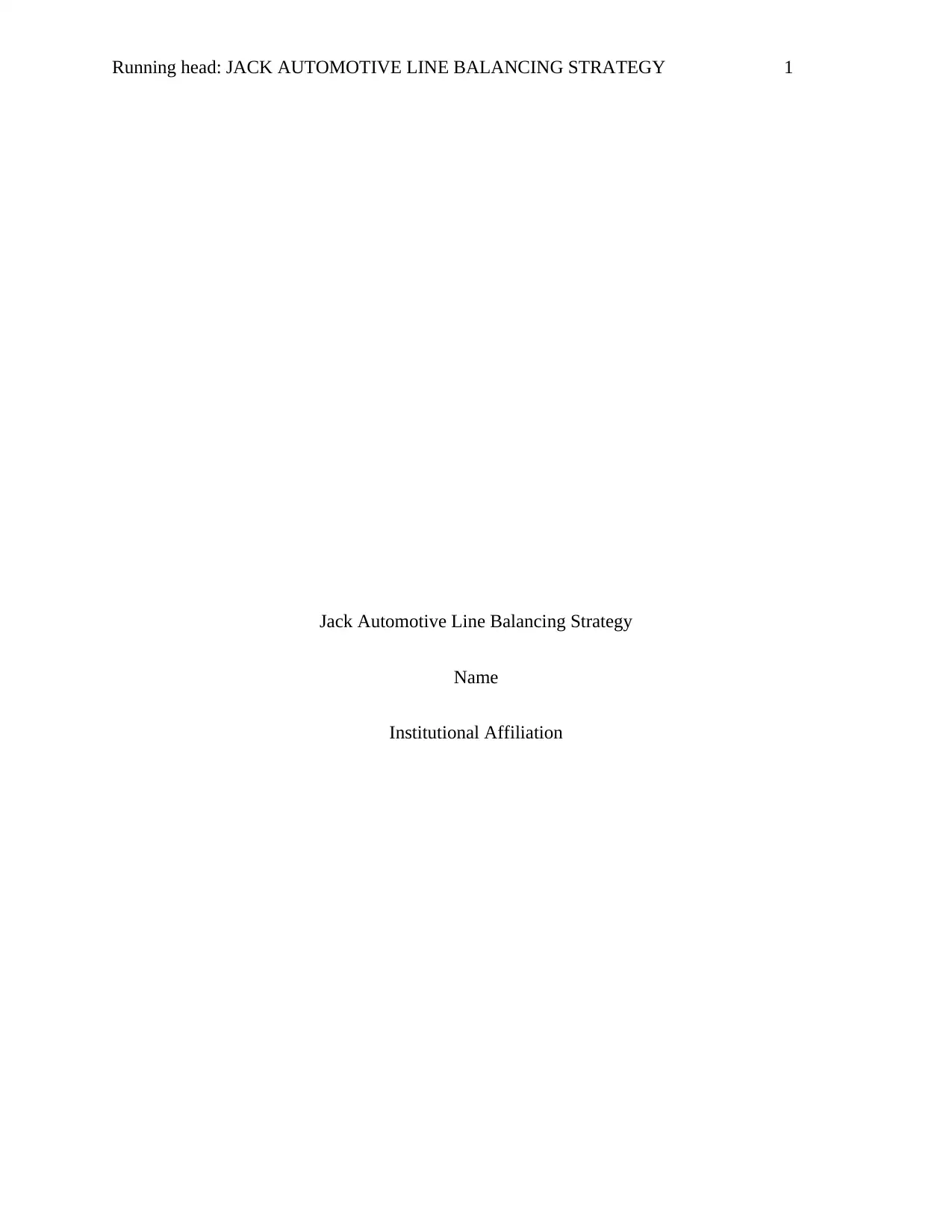
Running head: JACK AUTOMOTIVE LINE BALANCING STRATEGY 1
Jack Automotive Line Balancing Strategy
Name
Institutional Affiliation
Jack Automotive Line Balancing Strategy
Name
Institutional Affiliation
Paraphrase This Document
Need a fresh take? Get an instant paraphrase of this document with our AI Paraphraser
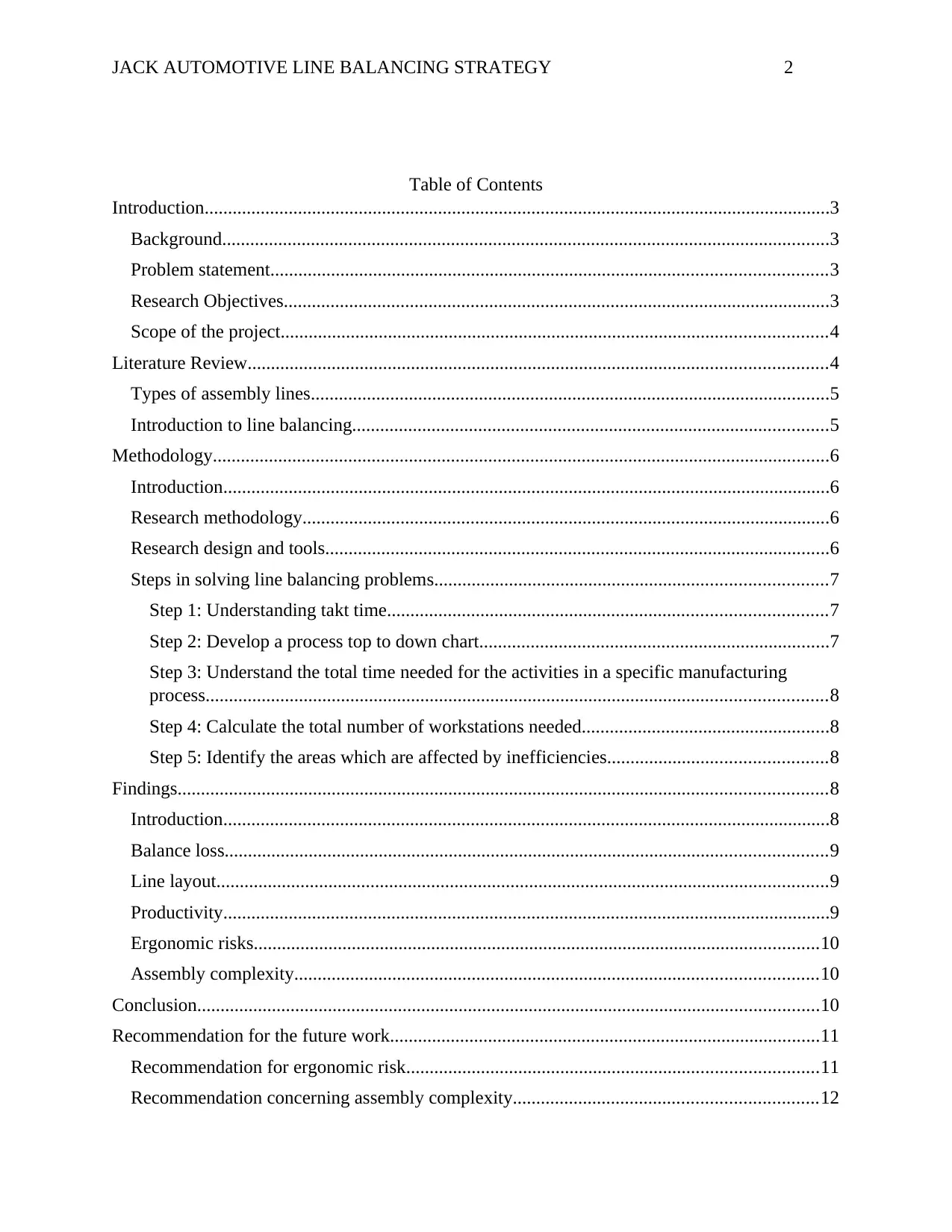
JACK AUTOMOTIVE LINE BALANCING STRATEGY 2
Table of Contents
Introduction......................................................................................................................................3
Background..................................................................................................................................3
Problem statement.......................................................................................................................3
Research Objectives.....................................................................................................................3
Scope of the project.....................................................................................................................4
Literature Review............................................................................................................................4
Types of assembly lines...............................................................................................................5
Introduction to line balancing......................................................................................................5
Methodology....................................................................................................................................6
Introduction..................................................................................................................................6
Research methodology.................................................................................................................6
Research design and tools............................................................................................................6
Steps in solving line balancing problems....................................................................................7
Step 1: Understanding takt time..............................................................................................7
Step 2: Develop a process top to down chart...........................................................................7
Step 3: Understand the total time needed for the activities in a specific manufacturing
process.....................................................................................................................................8
Step 4: Calculate the total number of workstations needed.....................................................8
Step 5: Identify the areas which are affected by inefficiencies...............................................8
Findings...........................................................................................................................................8
Introduction..................................................................................................................................8
Balance loss.................................................................................................................................9
Line layout...................................................................................................................................9
Productivity..................................................................................................................................9
Ergonomic risks.........................................................................................................................10
Assembly complexity................................................................................................................10
Conclusion.....................................................................................................................................10
Recommendation for the future work............................................................................................11
Recommendation for ergonomic risk........................................................................................11
Recommendation concerning assembly complexity.................................................................12
Table of Contents
Introduction......................................................................................................................................3
Background..................................................................................................................................3
Problem statement.......................................................................................................................3
Research Objectives.....................................................................................................................3
Scope of the project.....................................................................................................................4
Literature Review............................................................................................................................4
Types of assembly lines...............................................................................................................5
Introduction to line balancing......................................................................................................5
Methodology....................................................................................................................................6
Introduction..................................................................................................................................6
Research methodology.................................................................................................................6
Research design and tools............................................................................................................6
Steps in solving line balancing problems....................................................................................7
Step 1: Understanding takt time..............................................................................................7
Step 2: Develop a process top to down chart...........................................................................7
Step 3: Understand the total time needed for the activities in a specific manufacturing
process.....................................................................................................................................8
Step 4: Calculate the total number of workstations needed.....................................................8
Step 5: Identify the areas which are affected by inefficiencies...............................................8
Findings...........................................................................................................................................8
Introduction..................................................................................................................................8
Balance loss.................................................................................................................................9
Line layout...................................................................................................................................9
Productivity..................................................................................................................................9
Ergonomic risks.........................................................................................................................10
Assembly complexity................................................................................................................10
Conclusion.....................................................................................................................................10
Recommendation for the future work............................................................................................11
Recommendation for ergonomic risk........................................................................................11
Recommendation concerning assembly complexity.................................................................12
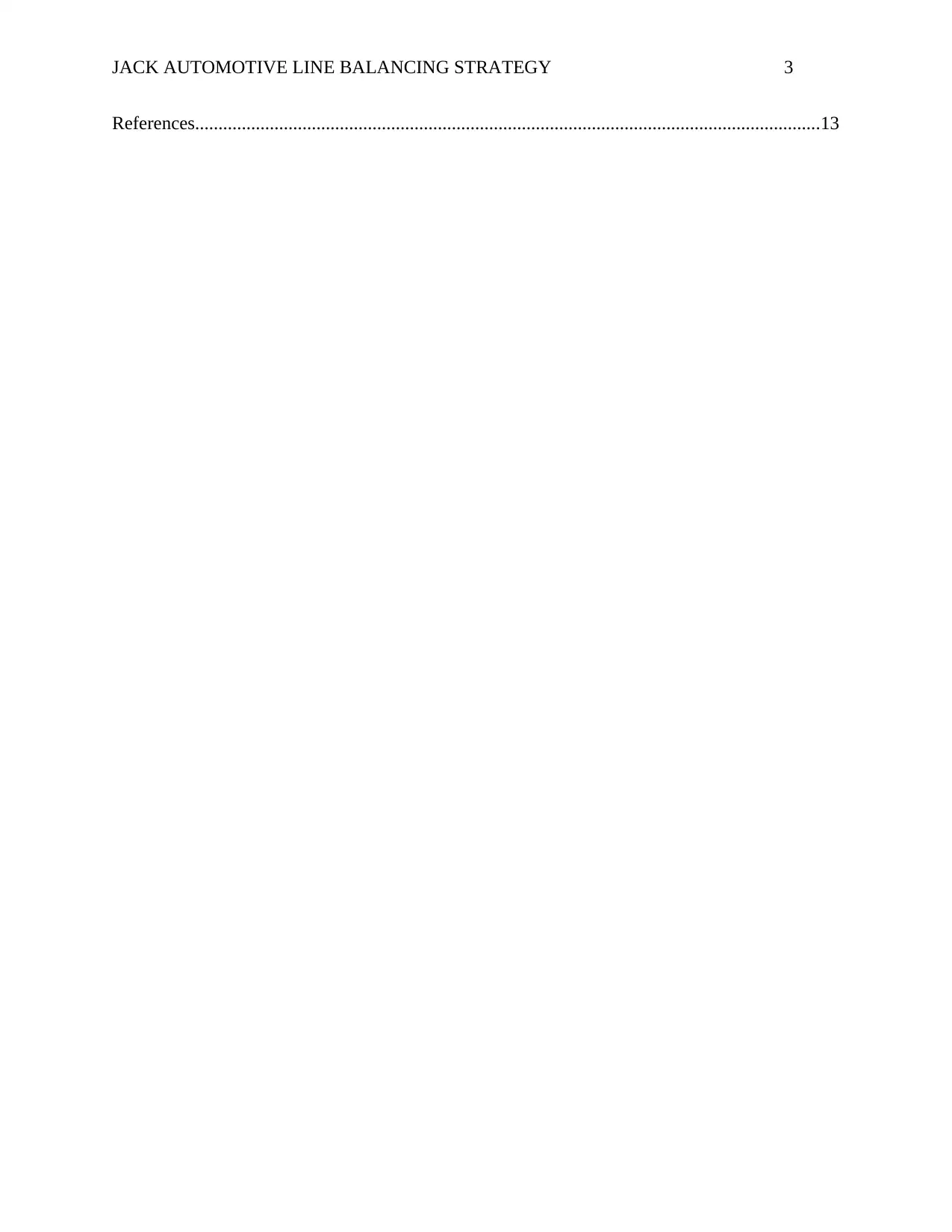
JACK AUTOMOTIVE LINE BALANCING STRATEGY 3
References......................................................................................................................................13
References......................................................................................................................................13
⊘ This is a preview!⊘
Do you want full access?
Subscribe today to unlock all pages.

Trusted by 1+ million students worldwide
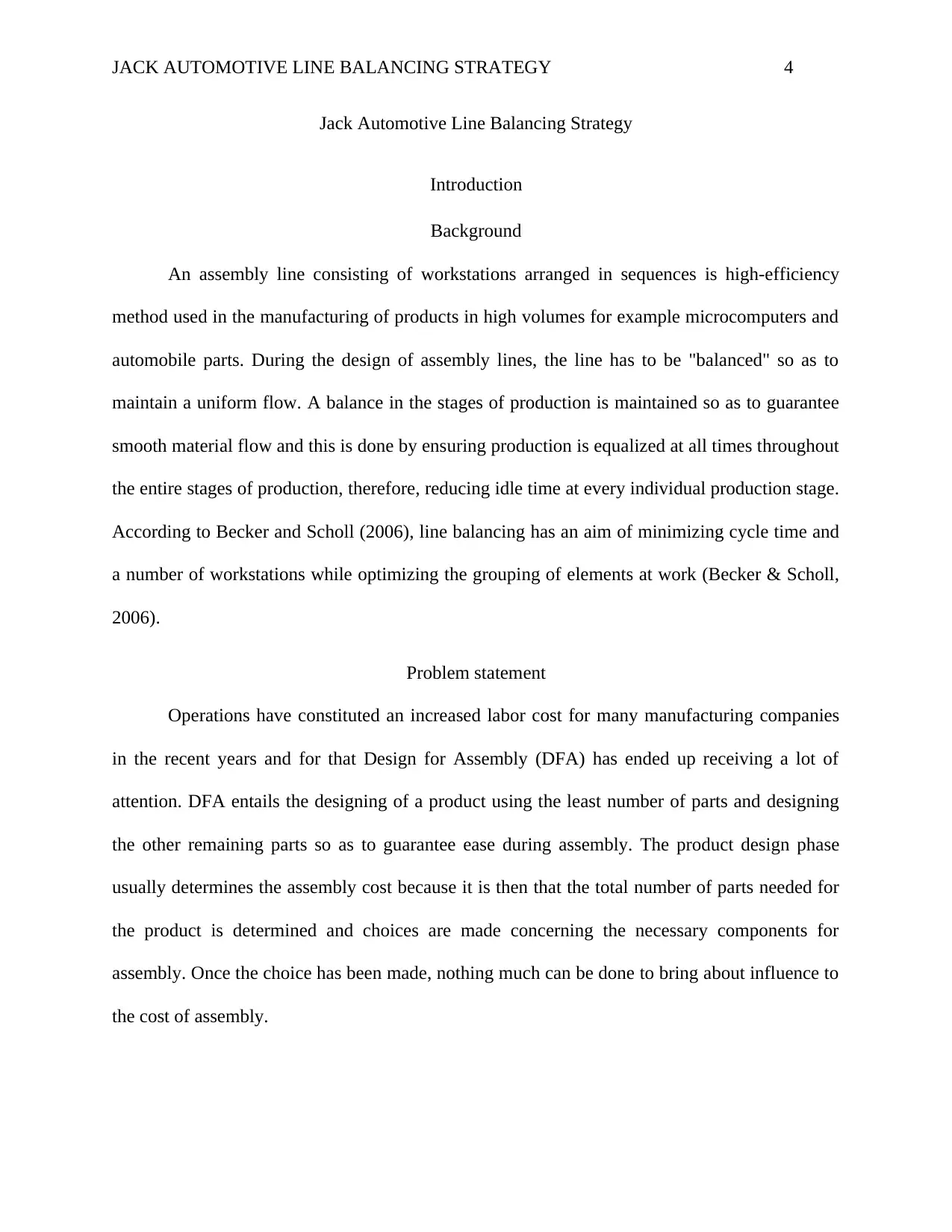
JACK AUTOMOTIVE LINE BALANCING STRATEGY 4
Jack Automotive Line Balancing Strategy
Introduction
Background
An assembly line consisting of workstations arranged in sequences is high-efficiency
method used in the manufacturing of products in high volumes for example microcomputers and
automobile parts. During the design of assembly lines, the line has to be "balanced" so as to
maintain a uniform flow. A balance in the stages of production is maintained so as to guarantee
smooth material flow and this is done by ensuring production is equalized at all times throughout
the entire stages of production, therefore, reducing idle time at every individual production stage.
According to Becker and Scholl (2006), line balancing has an aim of minimizing cycle time and
a number of workstations while optimizing the grouping of elements at work (Becker & Scholl,
2006).
Problem statement
Operations have constituted an increased labor cost for many manufacturing companies
in the recent years and for that Design for Assembly (DFA) has ended up receiving a lot of
attention. DFA entails the designing of a product using the least number of parts and designing
the other remaining parts so as to guarantee ease during assembly. The product design phase
usually determines the assembly cost because it is then that the total number of parts needed for
the product is determined and choices are made concerning the necessary components for
assembly. Once the choice has been made, nothing much can be done to bring about influence to
the cost of assembly.
Jack Automotive Line Balancing Strategy
Introduction
Background
An assembly line consisting of workstations arranged in sequences is high-efficiency
method used in the manufacturing of products in high volumes for example microcomputers and
automobile parts. During the design of assembly lines, the line has to be "balanced" so as to
maintain a uniform flow. A balance in the stages of production is maintained so as to guarantee
smooth material flow and this is done by ensuring production is equalized at all times throughout
the entire stages of production, therefore, reducing idle time at every individual production stage.
According to Becker and Scholl (2006), line balancing has an aim of minimizing cycle time and
a number of workstations while optimizing the grouping of elements at work (Becker & Scholl,
2006).
Problem statement
Operations have constituted an increased labor cost for many manufacturing companies
in the recent years and for that Design for Assembly (DFA) has ended up receiving a lot of
attention. DFA entails the designing of a product using the least number of parts and designing
the other remaining parts so as to guarantee ease during assembly. The product design phase
usually determines the assembly cost because it is then that the total number of parts needed for
the product is determined and choices are made concerning the necessary components for
assembly. Once the choice has been made, nothing much can be done to bring about influence to
the cost of assembly.
Paraphrase This Document
Need a fresh take? Get an instant paraphrase of this document with our AI Paraphraser
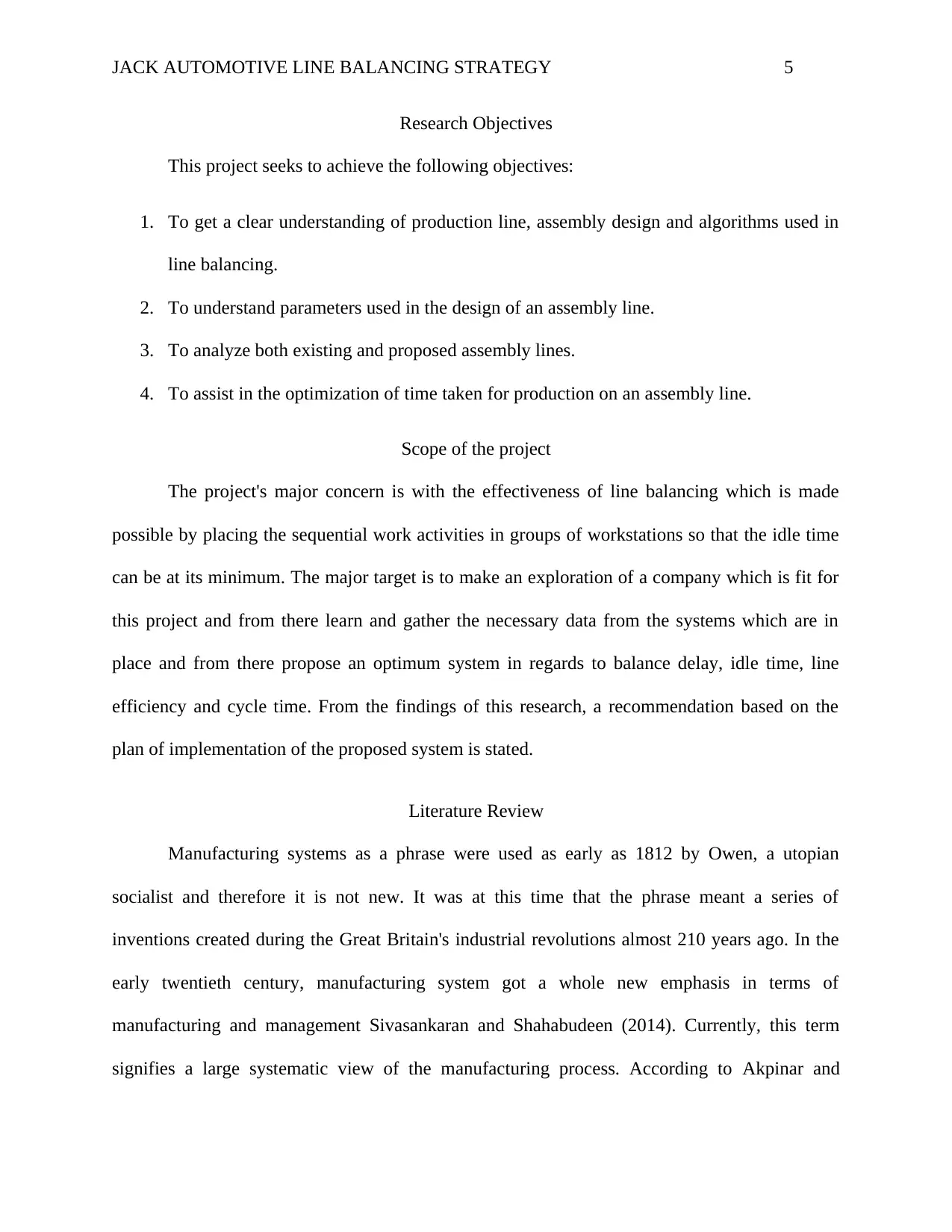
JACK AUTOMOTIVE LINE BALANCING STRATEGY 5
Research Objectives
This project seeks to achieve the following objectives:
1. To get a clear understanding of production line, assembly design and algorithms used in
line balancing.
2. To understand parameters used in the design of an assembly line.
3. To analyze both existing and proposed assembly lines.
4. To assist in the optimization of time taken for production on an assembly line.
Scope of the project
The project's major concern is with the effectiveness of line balancing which is made
possible by placing the sequential work activities in groups of workstations so that the idle time
can be at its minimum. The major target is to make an exploration of a company which is fit for
this project and from there learn and gather the necessary data from the systems which are in
place and from there propose an optimum system in regards to balance delay, idle time, line
efficiency and cycle time. From the findings of this research, a recommendation based on the
plan of implementation of the proposed system is stated.
Literature Review
Manufacturing systems as a phrase were used as early as 1812 by Owen, a utopian
socialist and therefore it is not new. It was at this time that the phrase meant a series of
inventions created during the Great Britain's industrial revolutions almost 210 years ago. In the
early twentieth century, manufacturing system got a whole new emphasis in terms of
manufacturing and management Sivasankaran and Shahabudeen (2014). Currently, this term
signifies a large systematic view of the manufacturing process. According to Akpinar and
Research Objectives
This project seeks to achieve the following objectives:
1. To get a clear understanding of production line, assembly design and algorithms used in
line balancing.
2. To understand parameters used in the design of an assembly line.
3. To analyze both existing and proposed assembly lines.
4. To assist in the optimization of time taken for production on an assembly line.
Scope of the project
The project's major concern is with the effectiveness of line balancing which is made
possible by placing the sequential work activities in groups of workstations so that the idle time
can be at its minimum. The major target is to make an exploration of a company which is fit for
this project and from there learn and gather the necessary data from the systems which are in
place and from there propose an optimum system in regards to balance delay, idle time, line
efficiency and cycle time. From the findings of this research, a recommendation based on the
plan of implementation of the proposed system is stated.
Literature Review
Manufacturing systems as a phrase were used as early as 1812 by Owen, a utopian
socialist and therefore it is not new. It was at this time that the phrase meant a series of
inventions created during the Great Britain's industrial revolutions almost 210 years ago. In the
early twentieth century, manufacturing system got a whole new emphasis in terms of
manufacturing and management Sivasankaran and Shahabudeen (2014). Currently, this term
signifies a large systematic view of the manufacturing process. According to Akpinar and
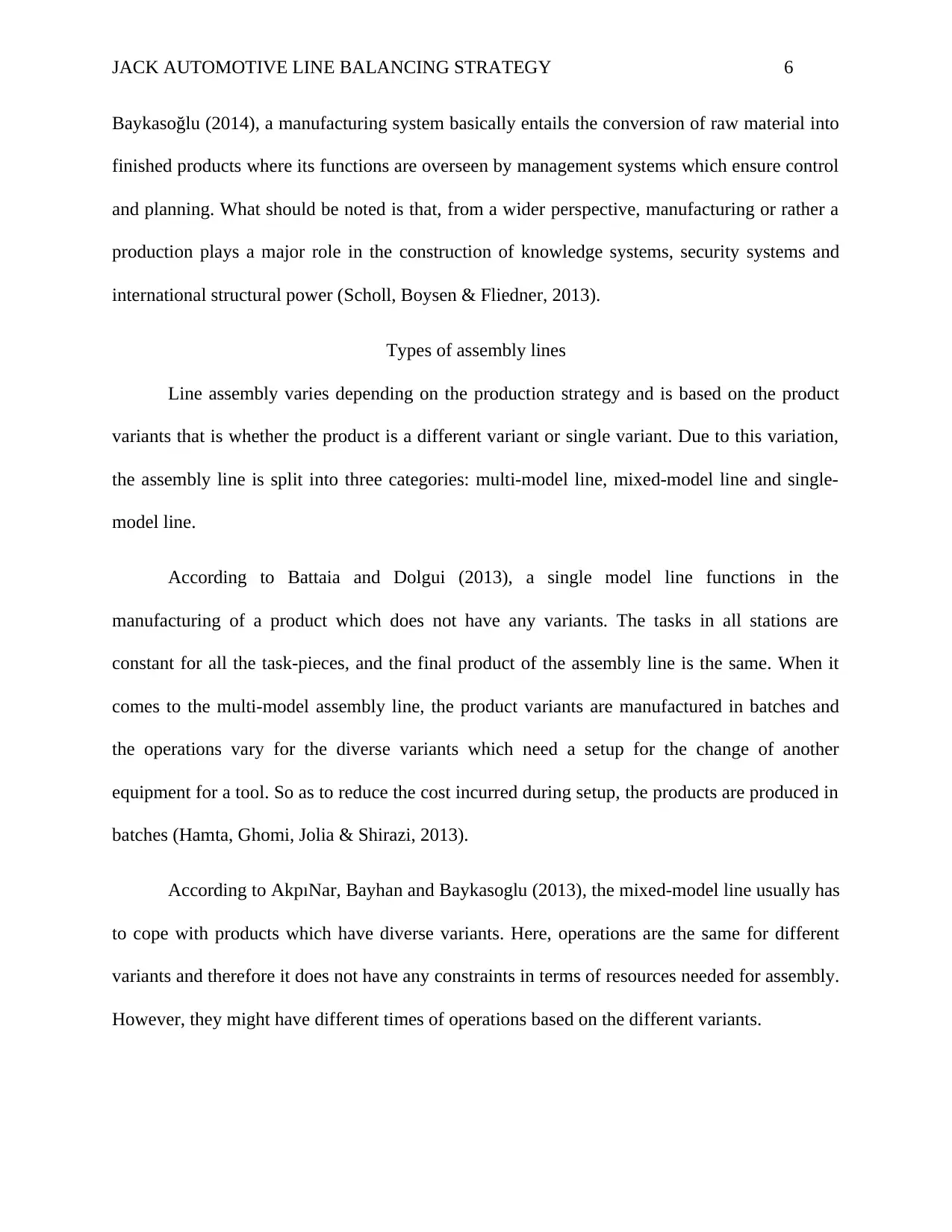
JACK AUTOMOTIVE LINE BALANCING STRATEGY 6
Baykasoğlu (2014), a manufacturing system basically entails the conversion of raw material into
finished products where its functions are overseen by management systems which ensure control
and planning. What should be noted is that, from a wider perspective, manufacturing or rather a
production plays a major role in the construction of knowledge systems, security systems and
international structural power (Scholl, Boysen & Fliedner, 2013).
Types of assembly lines
Line assembly varies depending on the production strategy and is based on the product
variants that is whether the product is a different variant or single variant. Due to this variation,
the assembly line is split into three categories: multi-model line, mixed-model line and single-
model line.
According to Battaia and Dolgui (2013), a single model line functions in the
manufacturing of a product which does not have any variants. The tasks in all stations are
constant for all the task-pieces, and the final product of the assembly line is the same. When it
comes to the multi-model assembly line, the product variants are manufactured in batches and
the operations vary for the diverse variants which need a setup for the change of another
equipment for a tool. So as to reduce the cost incurred during setup, the products are produced in
batches (Hamta, Ghomi, Jolia & Shirazi, 2013).
According to AkpıNar, Bayhan and Baykasoglu (2013), the mixed-model line usually has
to cope with products which have diverse variants. Here, operations are the same for different
variants and therefore it does not have any constraints in terms of resources needed for assembly.
However, they might have different times of operations based on the different variants.
Baykasoğlu (2014), a manufacturing system basically entails the conversion of raw material into
finished products where its functions are overseen by management systems which ensure control
and planning. What should be noted is that, from a wider perspective, manufacturing or rather a
production plays a major role in the construction of knowledge systems, security systems and
international structural power (Scholl, Boysen & Fliedner, 2013).
Types of assembly lines
Line assembly varies depending on the production strategy and is based on the product
variants that is whether the product is a different variant or single variant. Due to this variation,
the assembly line is split into three categories: multi-model line, mixed-model line and single-
model line.
According to Battaia and Dolgui (2013), a single model line functions in the
manufacturing of a product which does not have any variants. The tasks in all stations are
constant for all the task-pieces, and the final product of the assembly line is the same. When it
comes to the multi-model assembly line, the product variants are manufactured in batches and
the operations vary for the diverse variants which need a setup for the change of another
equipment for a tool. So as to reduce the cost incurred during setup, the products are produced in
batches (Hamta, Ghomi, Jolia & Shirazi, 2013).
According to AkpıNar, Bayhan and Baykasoglu (2013), the mixed-model line usually has
to cope with products which have diverse variants. Here, operations are the same for different
variants and therefore it does not have any constraints in terms of resources needed for assembly.
However, they might have different times of operations based on the different variants.
⊘ This is a preview!⊘
Do you want full access?
Subscribe today to unlock all pages.

Trusted by 1+ million students worldwide
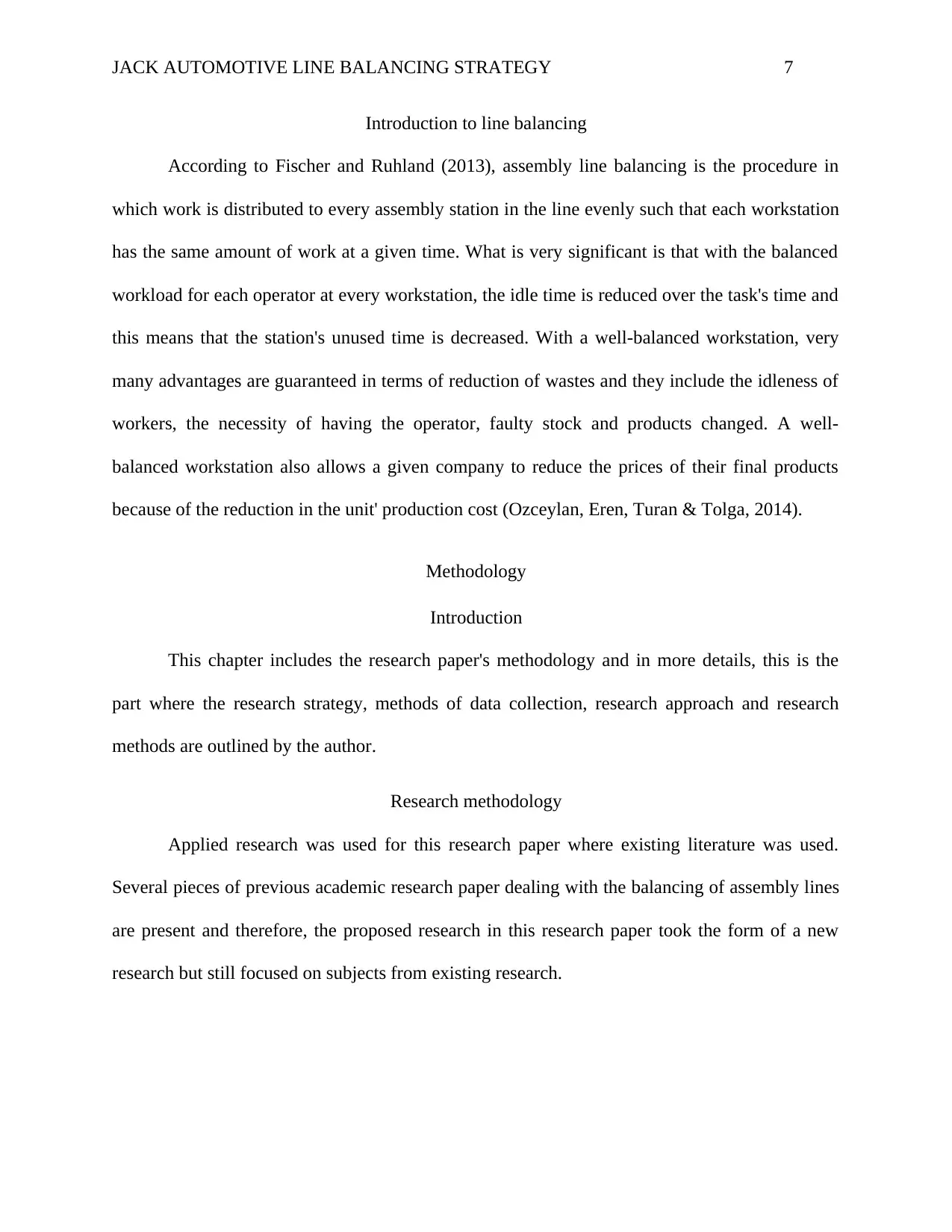
JACK AUTOMOTIVE LINE BALANCING STRATEGY 7
Introduction to line balancing
According to Fischer and Ruhland (2013), assembly line balancing is the procedure in
which work is distributed to every assembly station in the line evenly such that each workstation
has the same amount of work at a given time. What is very significant is that with the balanced
workload for each operator at every workstation, the idle time is reduced over the task's time and
this means that the station's unused time is decreased. With a well-balanced workstation, very
many advantages are guaranteed in terms of reduction of wastes and they include the idleness of
workers, the necessity of having the operator, faulty stock and products changed. A well-
balanced workstation also allows a given company to reduce the prices of their final products
because of the reduction in the unit' production cost (Ozceylan, Eren, Turan & Tolga, 2014).
Methodology
Introduction
This chapter includes the research paper's methodology and in more details, this is the
part where the research strategy, methods of data collection, research approach and research
methods are outlined by the author.
Research methodology
Applied research was used for this research paper where existing literature was used.
Several pieces of previous academic research paper dealing with the balancing of assembly lines
are present and therefore, the proposed research in this research paper took the form of a new
research but still focused on subjects from existing research.
Introduction to line balancing
According to Fischer and Ruhland (2013), assembly line balancing is the procedure in
which work is distributed to every assembly station in the line evenly such that each workstation
has the same amount of work at a given time. What is very significant is that with the balanced
workload for each operator at every workstation, the idle time is reduced over the task's time and
this means that the station's unused time is decreased. With a well-balanced workstation, very
many advantages are guaranteed in terms of reduction of wastes and they include the idleness of
workers, the necessity of having the operator, faulty stock and products changed. A well-
balanced workstation also allows a given company to reduce the prices of their final products
because of the reduction in the unit' production cost (Ozceylan, Eren, Turan & Tolga, 2014).
Methodology
Introduction
This chapter includes the research paper's methodology and in more details, this is the
part where the research strategy, methods of data collection, research approach and research
methods are outlined by the author.
Research methodology
Applied research was used for this research paper where existing literature was used.
Several pieces of previous academic research paper dealing with the balancing of assembly lines
are present and therefore, the proposed research in this research paper took the form of a new
research but still focused on subjects from existing research.
Paraphrase This Document
Need a fresh take? Get an instant paraphrase of this document with our AI Paraphraser
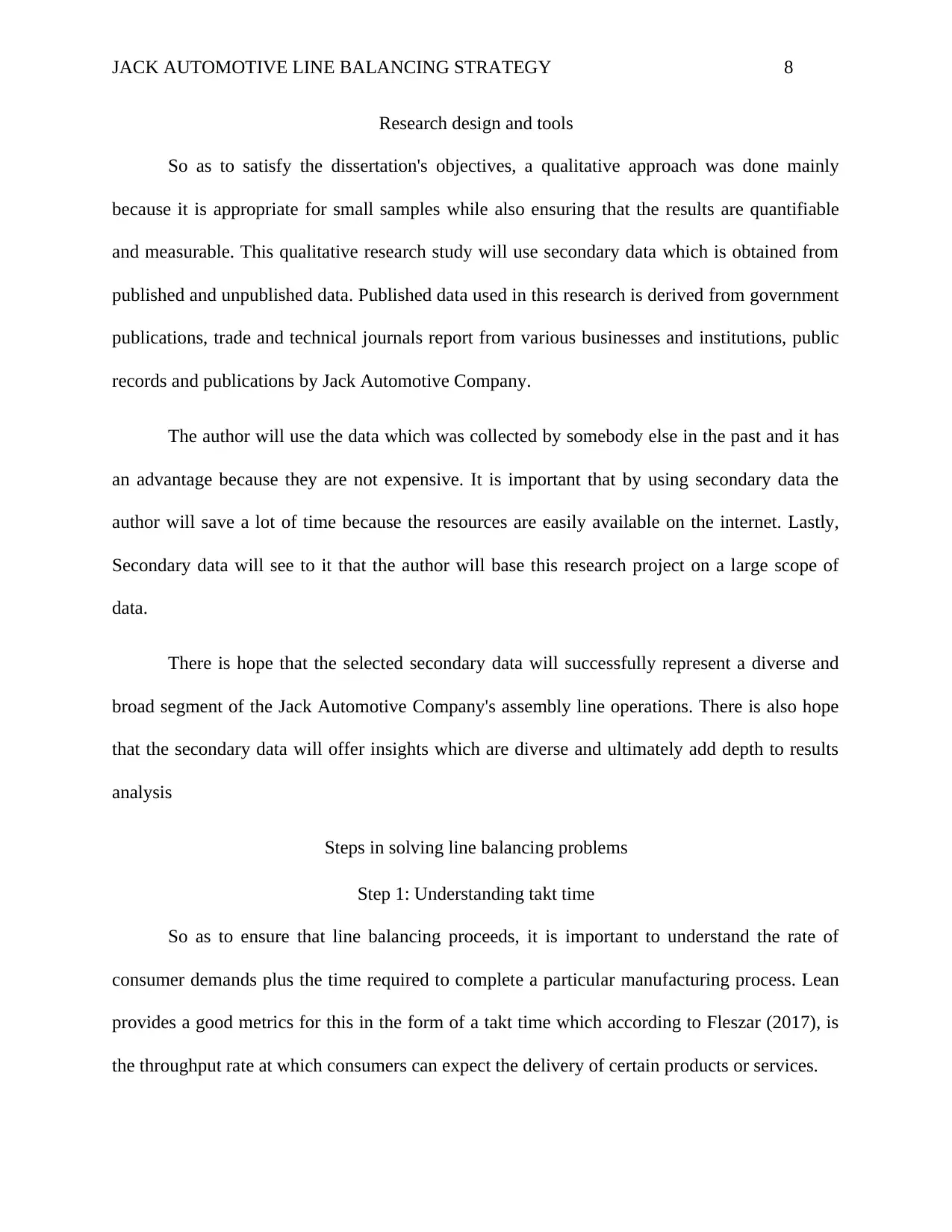
JACK AUTOMOTIVE LINE BALANCING STRATEGY 8
Research design and tools
So as to satisfy the dissertation's objectives, a qualitative approach was done mainly
because it is appropriate for small samples while also ensuring that the results are quantifiable
and measurable. This qualitative research study will use secondary data which is obtained from
published and unpublished data. Published data used in this research is derived from government
publications, trade and technical journals report from various businesses and institutions, public
records and publications by Jack Automotive Company.
The author will use the data which was collected by somebody else in the past and it has
an advantage because they are not expensive. It is important that by using secondary data the
author will save a lot of time because the resources are easily available on the internet. Lastly,
Secondary data will see to it that the author will base this research project on a large scope of
data.
There is hope that the selected secondary data will successfully represent a diverse and
broad segment of the Jack Automotive Company's assembly line operations. There is also hope
that the secondary data will offer insights which are diverse and ultimately add depth to results
analysis
Steps in solving line balancing problems
Step 1: Understanding takt time
So as to ensure that line balancing proceeds, it is important to understand the rate of
consumer demands plus the time required to complete a particular manufacturing process. Lean
provides a good metrics for this in the form of a takt time which according to Fleszar (2017), is
the throughput rate at which consumers can expect the delivery of certain products or services.
Research design and tools
So as to satisfy the dissertation's objectives, a qualitative approach was done mainly
because it is appropriate for small samples while also ensuring that the results are quantifiable
and measurable. This qualitative research study will use secondary data which is obtained from
published and unpublished data. Published data used in this research is derived from government
publications, trade and technical journals report from various businesses and institutions, public
records and publications by Jack Automotive Company.
The author will use the data which was collected by somebody else in the past and it has
an advantage because they are not expensive. It is important that by using secondary data the
author will save a lot of time because the resources are easily available on the internet. Lastly,
Secondary data will see to it that the author will base this research project on a large scope of
data.
There is hope that the selected secondary data will successfully represent a diverse and
broad segment of the Jack Automotive Company's assembly line operations. There is also hope
that the secondary data will offer insights which are diverse and ultimately add depth to results
analysis
Steps in solving line balancing problems
Step 1: Understanding takt time
So as to ensure that line balancing proceeds, it is important to understand the rate of
consumer demands plus the time required to complete a particular manufacturing process. Lean
provides a good metrics for this in the form of a takt time which according to Fleszar (2017), is
the throughput rate at which consumers can expect the delivery of certain products or services.
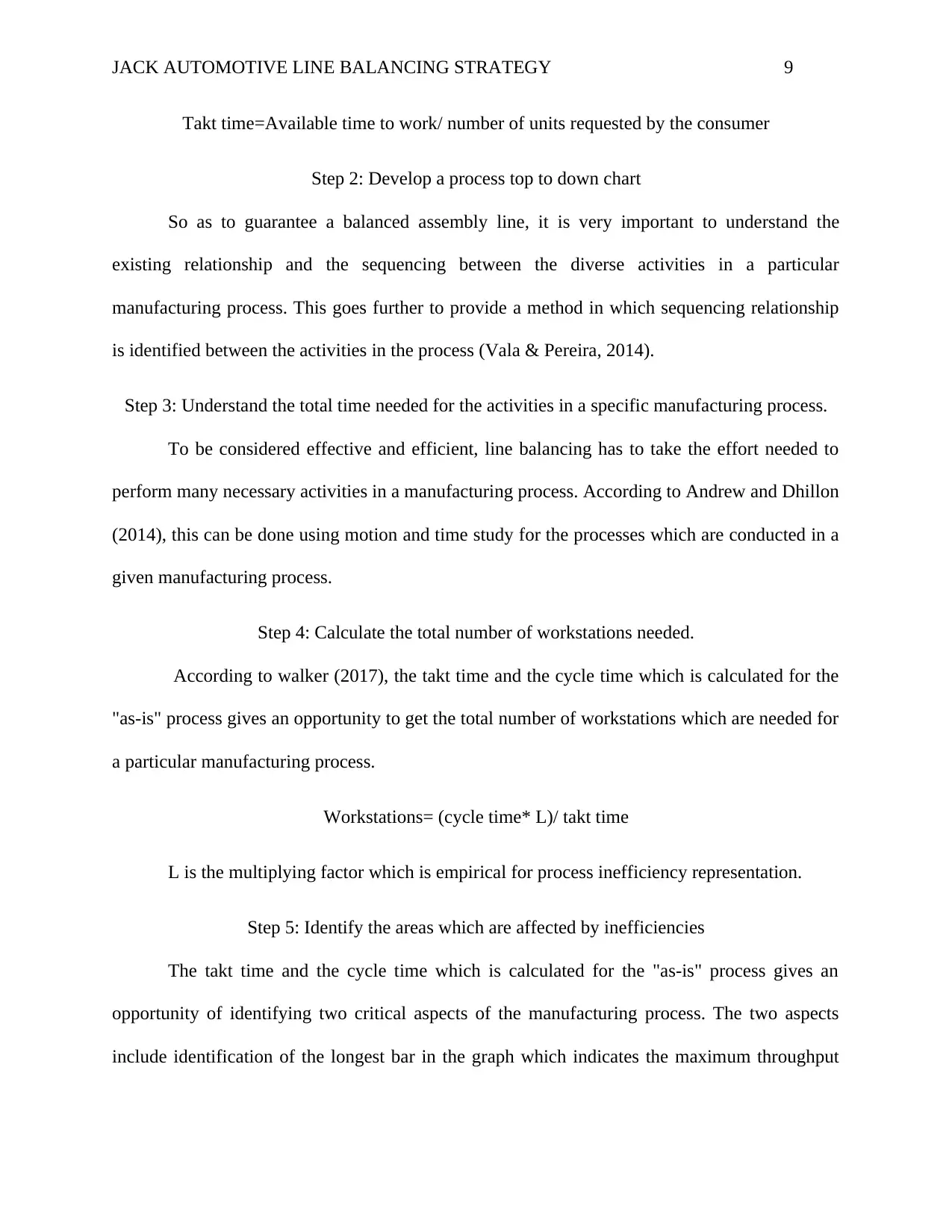
JACK AUTOMOTIVE LINE BALANCING STRATEGY 9
Takt time=Available time to work/ number of units requested by the consumer
Step 2: Develop a process top to down chart
So as to guarantee a balanced assembly line, it is very important to understand the
existing relationship and the sequencing between the diverse activities in a particular
manufacturing process. This goes further to provide a method in which sequencing relationship
is identified between the activities in the process (Vala & Pereira, 2014).
Step 3: Understand the total time needed for the activities in a specific manufacturing process.
To be considered effective and efficient, line balancing has to take the effort needed to
perform many necessary activities in a manufacturing process. According to Andrew and Dhillon
(2014), this can be done using motion and time study for the processes which are conducted in a
given manufacturing process.
Step 4: Calculate the total number of workstations needed.
According to walker (2017), the takt time and the cycle time which is calculated for the
"as-is" process gives an opportunity to get the total number of workstations which are needed for
a particular manufacturing process.
Workstations= (cycle time* L)/ takt time
L is the multiplying factor which is empirical for process inefficiency representation.
Step 5: Identify the areas which are affected by inefficiencies
The takt time and the cycle time which is calculated for the "as-is" process gives an
opportunity of identifying two critical aspects of the manufacturing process. The two aspects
include identification of the longest bar in the graph which indicates the maximum throughput
Takt time=Available time to work/ number of units requested by the consumer
Step 2: Develop a process top to down chart
So as to guarantee a balanced assembly line, it is very important to understand the
existing relationship and the sequencing between the diverse activities in a particular
manufacturing process. This goes further to provide a method in which sequencing relationship
is identified between the activities in the process (Vala & Pereira, 2014).
Step 3: Understand the total time needed for the activities in a specific manufacturing process.
To be considered effective and efficient, line balancing has to take the effort needed to
perform many necessary activities in a manufacturing process. According to Andrew and Dhillon
(2014), this can be done using motion and time study for the processes which are conducted in a
given manufacturing process.
Step 4: Calculate the total number of workstations needed.
According to walker (2017), the takt time and the cycle time which is calculated for the
"as-is" process gives an opportunity to get the total number of workstations which are needed for
a particular manufacturing process.
Workstations= (cycle time* L)/ takt time
L is the multiplying factor which is empirical for process inefficiency representation.
Step 5: Identify the areas which are affected by inefficiencies
The takt time and the cycle time which is calculated for the "as-is" process gives an
opportunity of identifying two critical aspects of the manufacturing process. The two aspects
include identification of the longest bar in the graph which indicates the maximum throughput
⊘ This is a preview!⊘
Do you want full access?
Subscribe today to unlock all pages.

Trusted by 1+ million students worldwide
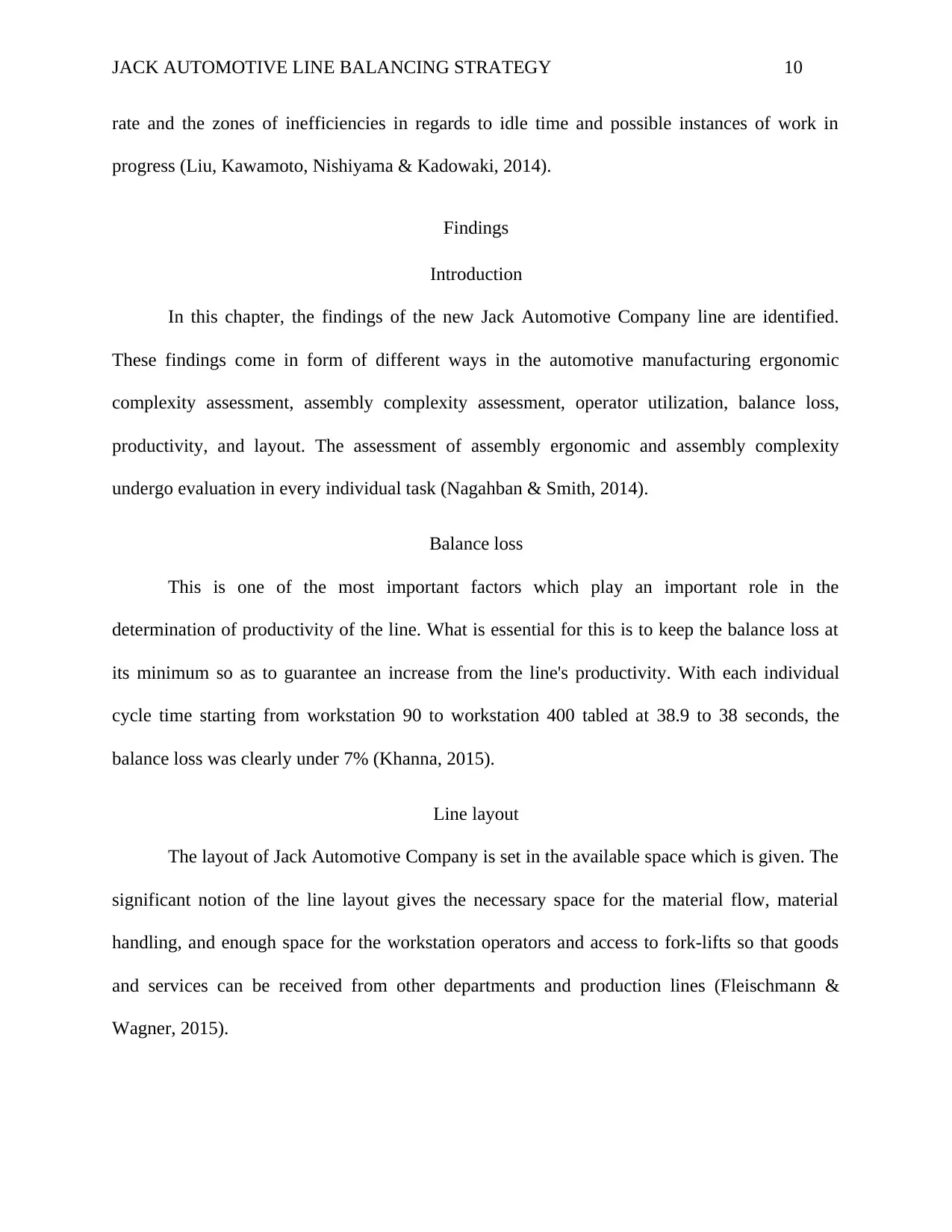
JACK AUTOMOTIVE LINE BALANCING STRATEGY 10
rate and the zones of inefficiencies in regards to idle time and possible instances of work in
progress (Liu, Kawamoto, Nishiyama & Kadowaki, 2014).
Findings
Introduction
In this chapter, the findings of the new Jack Automotive Company line are identified.
These findings come in form of different ways in the automotive manufacturing ergonomic
complexity assessment, assembly complexity assessment, operator utilization, balance loss,
productivity, and layout. The assessment of assembly ergonomic and assembly complexity
undergo evaluation in every individual task (Nagahban & Smith, 2014).
Balance loss
This is one of the most important factors which play an important role in the
determination of productivity of the line. What is essential for this is to keep the balance loss at
its minimum so as to guarantee an increase from the line's productivity. With each individual
cycle time starting from workstation 90 to workstation 400 tabled at 38.9 to 38 seconds, the
balance loss was clearly under 7% (Khanna, 2015).
Line layout
The layout of Jack Automotive Company is set in the available space which is given. The
significant notion of the line layout gives the necessary space for the material flow, material
handling, and enough space for the workstation operators and access to fork-lifts so that goods
and services can be received from other departments and production lines (Fleischmann &
Wagner, 2015).
rate and the zones of inefficiencies in regards to idle time and possible instances of work in
progress (Liu, Kawamoto, Nishiyama & Kadowaki, 2014).
Findings
Introduction
In this chapter, the findings of the new Jack Automotive Company line are identified.
These findings come in form of different ways in the automotive manufacturing ergonomic
complexity assessment, assembly complexity assessment, operator utilization, balance loss,
productivity, and layout. The assessment of assembly ergonomic and assembly complexity
undergo evaluation in every individual task (Nagahban & Smith, 2014).
Balance loss
This is one of the most important factors which play an important role in the
determination of productivity of the line. What is essential for this is to keep the balance loss at
its minimum so as to guarantee an increase from the line's productivity. With each individual
cycle time starting from workstation 90 to workstation 400 tabled at 38.9 to 38 seconds, the
balance loss was clearly under 7% (Khanna, 2015).
Line layout
The layout of Jack Automotive Company is set in the available space which is given. The
significant notion of the line layout gives the necessary space for the material flow, material
handling, and enough space for the workstation operators and access to fork-lifts so that goods
and services can be received from other departments and production lines (Fleischmann &
Wagner, 2015).
Paraphrase This Document
Need a fresh take? Get an instant paraphrase of this document with our AI Paraphraser
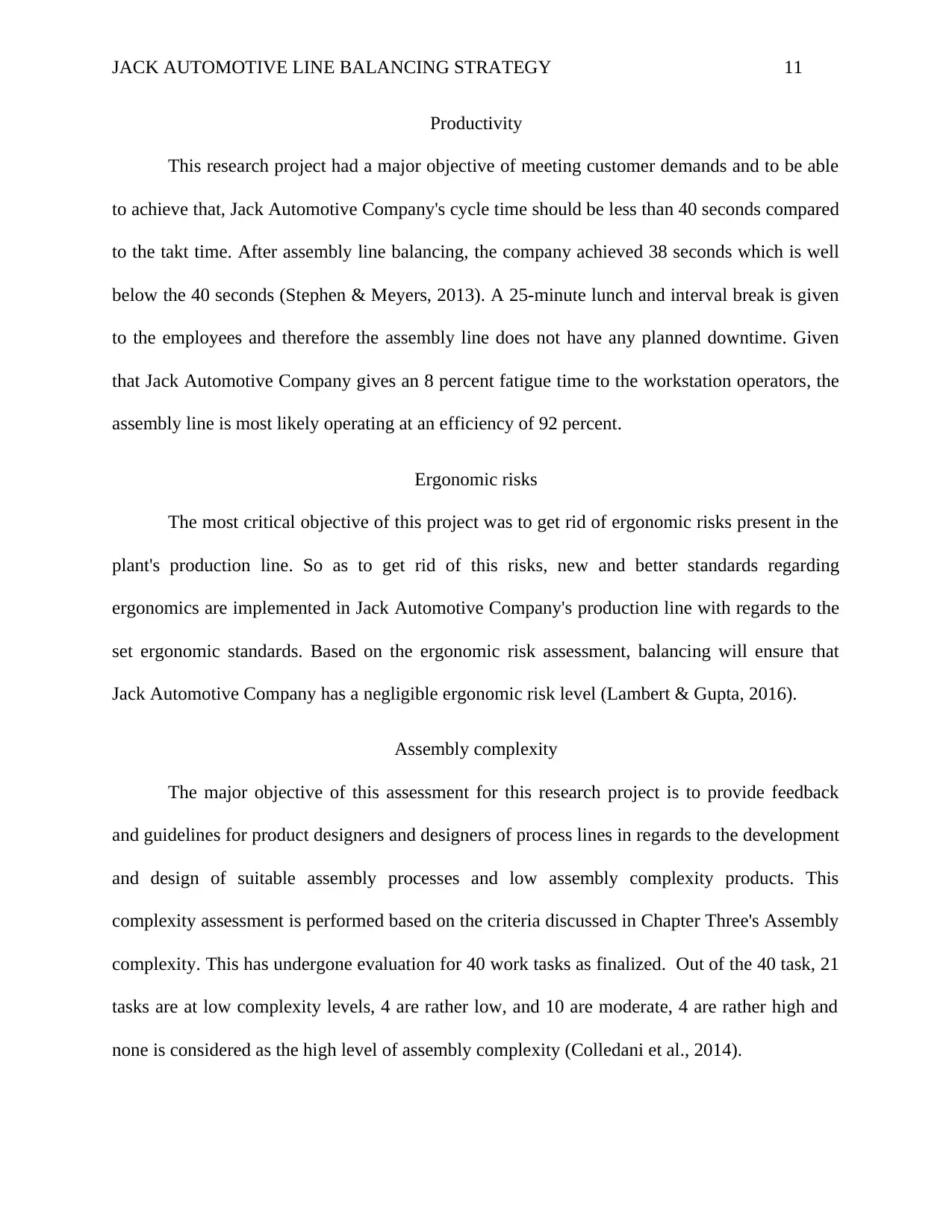
JACK AUTOMOTIVE LINE BALANCING STRATEGY 11
Productivity
This research project had a major objective of meeting customer demands and to be able
to achieve that, Jack Automotive Company's cycle time should be less than 40 seconds compared
to the takt time. After assembly line balancing, the company achieved 38 seconds which is well
below the 40 seconds (Stephen & Meyers, 2013). A 25-minute lunch and interval break is given
to the employees and therefore the assembly line does not have any planned downtime. Given
that Jack Automotive Company gives an 8 percent fatigue time to the workstation operators, the
assembly line is most likely operating at an efficiency of 92 percent.
Ergonomic risks
The most critical objective of this project was to get rid of ergonomic risks present in the
plant's production line. So as to get rid of this risks, new and better standards regarding
ergonomics are implemented in Jack Automotive Company's production line with regards to the
set ergonomic standards. Based on the ergonomic risk assessment, balancing will ensure that
Jack Automotive Company has a negligible ergonomic risk level (Lambert & Gupta, 2016).
Assembly complexity
The major objective of this assessment for this research project is to provide feedback
and guidelines for product designers and designers of process lines in regards to the development
and design of suitable assembly processes and low assembly complexity products. This
complexity assessment is performed based on the criteria discussed in Chapter Three's Assembly
complexity. This has undergone evaluation for 40 work tasks as finalized. Out of the 40 task, 21
tasks are at low complexity levels, 4 are rather low, and 10 are moderate, 4 are rather high and
none is considered as the high level of assembly complexity (Colledani et al., 2014).
Productivity
This research project had a major objective of meeting customer demands and to be able
to achieve that, Jack Automotive Company's cycle time should be less than 40 seconds compared
to the takt time. After assembly line balancing, the company achieved 38 seconds which is well
below the 40 seconds (Stephen & Meyers, 2013). A 25-minute lunch and interval break is given
to the employees and therefore the assembly line does not have any planned downtime. Given
that Jack Automotive Company gives an 8 percent fatigue time to the workstation operators, the
assembly line is most likely operating at an efficiency of 92 percent.
Ergonomic risks
The most critical objective of this project was to get rid of ergonomic risks present in the
plant's production line. So as to get rid of this risks, new and better standards regarding
ergonomics are implemented in Jack Automotive Company's production line with regards to the
set ergonomic standards. Based on the ergonomic risk assessment, balancing will ensure that
Jack Automotive Company has a negligible ergonomic risk level (Lambert & Gupta, 2016).
Assembly complexity
The major objective of this assessment for this research project is to provide feedback
and guidelines for product designers and designers of process lines in regards to the development
and design of suitable assembly processes and low assembly complexity products. This
complexity assessment is performed based on the criteria discussed in Chapter Three's Assembly
complexity. This has undergone evaluation for 40 work tasks as finalized. Out of the 40 task, 21
tasks are at low complexity levels, 4 are rather low, and 10 are moderate, 4 are rather high and
none is considered as the high level of assembly complexity (Colledani et al., 2014).
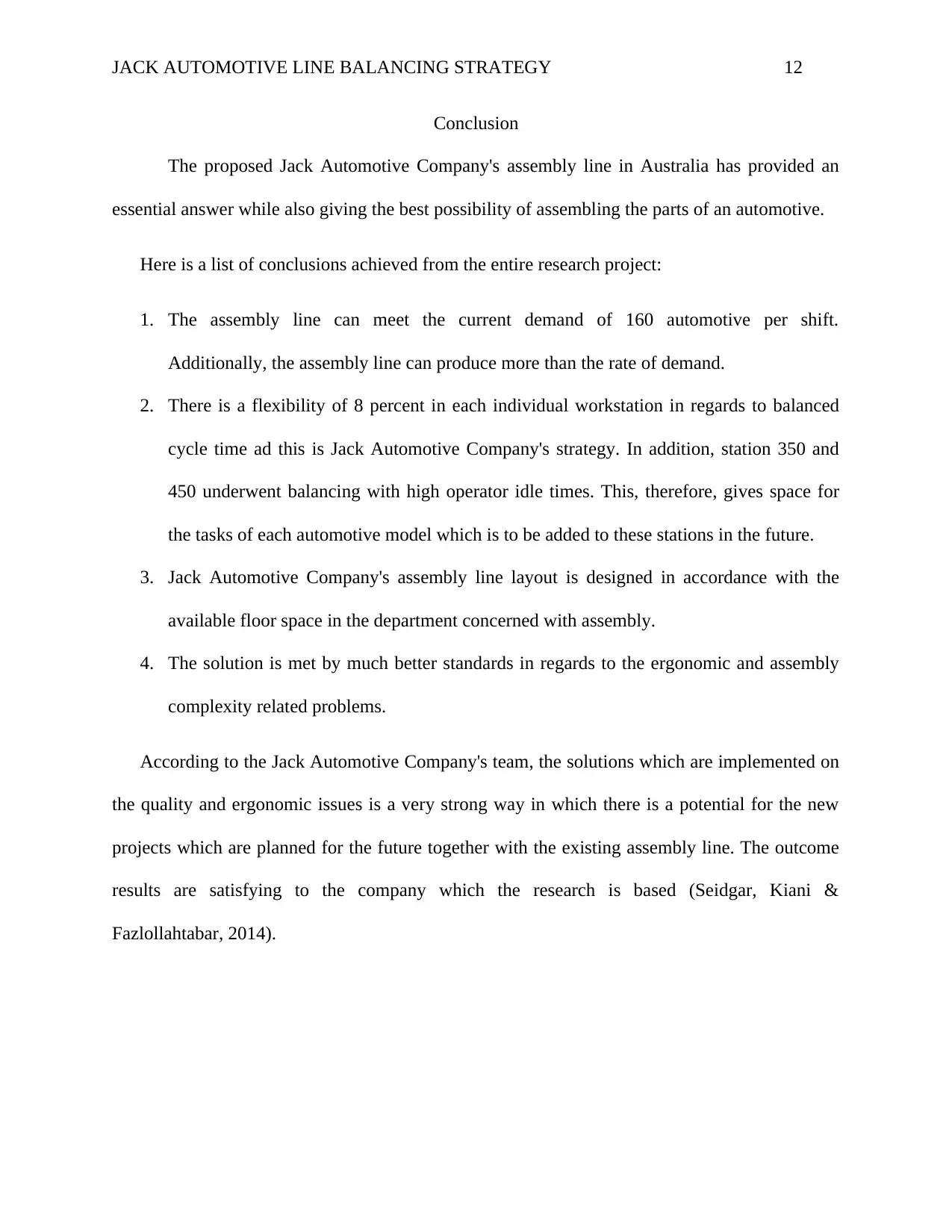
JACK AUTOMOTIVE LINE BALANCING STRATEGY 12
Conclusion
The proposed Jack Automotive Company's assembly line in Australia has provided an
essential answer while also giving the best possibility of assembling the parts of an automotive.
Here is a list of conclusions achieved from the entire research project:
1. The assembly line can meet the current demand of 160 automotive per shift.
Additionally, the assembly line can produce more than the rate of demand.
2. There is a flexibility of 8 percent in each individual workstation in regards to balanced
cycle time ad this is Jack Automotive Company's strategy. In addition, station 350 and
450 underwent balancing with high operator idle times. This, therefore, gives space for
the tasks of each automotive model which is to be added to these stations in the future.
3. Jack Automotive Company's assembly line layout is designed in accordance with the
available floor space in the department concerned with assembly.
4. The solution is met by much better standards in regards to the ergonomic and assembly
complexity related problems.
According to the Jack Automotive Company's team, the solutions which are implemented on
the quality and ergonomic issues is a very strong way in which there is a potential for the new
projects which are planned for the future together with the existing assembly line. The outcome
results are satisfying to the company which the research is based (Seidgar, Kiani &
Fazlollahtabar, 2014).
Conclusion
The proposed Jack Automotive Company's assembly line in Australia has provided an
essential answer while also giving the best possibility of assembling the parts of an automotive.
Here is a list of conclusions achieved from the entire research project:
1. The assembly line can meet the current demand of 160 automotive per shift.
Additionally, the assembly line can produce more than the rate of demand.
2. There is a flexibility of 8 percent in each individual workstation in regards to balanced
cycle time ad this is Jack Automotive Company's strategy. In addition, station 350 and
450 underwent balancing with high operator idle times. This, therefore, gives space for
the tasks of each automotive model which is to be added to these stations in the future.
3. Jack Automotive Company's assembly line layout is designed in accordance with the
available floor space in the department concerned with assembly.
4. The solution is met by much better standards in regards to the ergonomic and assembly
complexity related problems.
According to the Jack Automotive Company's team, the solutions which are implemented on
the quality and ergonomic issues is a very strong way in which there is a potential for the new
projects which are planned for the future together with the existing assembly line. The outcome
results are satisfying to the company which the research is based (Seidgar, Kiani &
Fazlollahtabar, 2014).
⊘ This is a preview!⊘
Do you want full access?
Subscribe today to unlock all pages.

Trusted by 1+ million students worldwide
1 out of 16
Related Documents
Your All-in-One AI-Powered Toolkit for Academic Success.
+13062052269
info@desklib.com
Available 24*7 on WhatsApp / Email
![[object Object]](/_next/static/media/star-bottom.7253800d.svg)
Unlock your academic potential
Copyright © 2020–2025 A2Z Services. All Rights Reserved. Developed and managed by ZUCOL.




